Association of Alumni and Alumnae of MIT
This has been another successful year for the Alumni Association. In spite of adverse external circumstances, our events around the world and on campus were well attended; the Alumni Fund exceeded its participation goal with 29,158 donors and raised $29.3 million for MIT; and alumni continued to rely on the online services of the Infinite Connection that forwarded its 100,000,000th email this year.
For the Alumni Association, the past year has been characterized by change. Our volunteer leaders looked at Association governance issues and led us through changes that strengthened the effectiveness of the Board of Directors. Our staff focused this year on process improvements, resulting in changes that led to a stronger, more efficient organization. The staff and alumni alike responded to changes at MIT as well as to external changes in world affairs including war, disease, and a sluggish economy. The year ended with my retirement from the position of executive vice president and chief executive officer and the appointment of Elizabeth A. Garvin HM as my successor, another major change for the organization.
Under the leadership of James A. Lash '66, Association president for 2002–2003, the Board of Directors and staff developed a set of performance measures to monitor service to MIT, service to alumni, and effective management. The Presidents Committee worked with staff to develop a spending policy for Association assets held in Institute fund accounts and to create routine quarterly financial forecasts and budget reports. In what may be its most significant initiative during the year, the Board began the first of an ongoing, systematic, series of strategic reviews of Association programs by appointing two ad hoc committees of volunteers who examined Class Giving and the MIT Travel Program. In addition, the Board and staff began an assessment of Association policies and procedures that will become a continuous process.
Notable process improvements included the development of online registration tools for Clubs Program and other alumni activities; a focus on proactive data management to improve data integrity; the re-launch of a newly designed Alumni Association Web site; improved online giving tools; online balloting for the National Selection Committee; the implementation of a new automated phonathon system; development of a system on the database to improve identification and recruitment of volunteers for leadership positions; planning for growth of the Email Forwarding for Life system; and a new web infrastructure to increase productivity. Let me note in particular three of these developments:
- SmarTrans—Association staff built a system to offer simple event registration and dues collection online. Although this product was developed primarily as a service to club volunteers, it also provides the same service to staff for Association events, and produces reports on club membership and event attendance previously unavailable to staff. This product had been requested by volunteers and staff for many months. Its successful launch this past June, on time and on budget, has been a real success story of FY2003.
- Data Integrity—With the hiring of a new data entry manager this past October, we created a data integrity team. The team's focus on proactive data cleanup and research, rather than just data entry, has dramatically increased the integrity of our alumni database, the Institute's database of record. Specific examples of some of the results of this effort are cited later in this report.
- Web Site Redesign—Because the Association's web pages had more than tripled since their last redesign in 2000, we developed a new web architecture that dramatically improved the site's organization, look, and accessibility. The new design included improved flexibility to allow the site to evolve as programs grow or contract. Staff from all units of the Association worked with Alumni Network Services staff on the new site. Launched this past June, it has been well received by alumni thus far.
MIT's fiscal constraints have affected the Association budgets along with all other units in the Institute. This past year, Association staff began to manage down, expecting a budget cut of just over 6 percent in FY2004 and even more in FY2005. For three budget years, the Association has drawn on its own outside income to cover some ongoing operating costs. The principal source of this income has been a credit card contract that concludes in FY2004. A new contract is not expected to be as lucrative, so staff and the Board have planned for significant cuts in resources outside the MIT budget. The staff has risen to the challenge in the face of reduced resources by taking on new tasks and streamlining operations. Despite these constraints, the quality of the Association's programs has remained high.
This past year, the United States was involved in a war in Iraq; the World Health Organization issued warnings about the dangers of SARS (sudden acute respiratory syndrome); and the world economy continued to be on the down turn. Even in the face of these external factors, alumni continued to support the Alumni Fund and to attend MIT events. We exceeded our goal of 29,000 donors and raised $29.3 million. Attendance at alumni events was strong, with sell-out crowds for some of our new young alumni and graduate alumni events. Reunion attendance was also strong even though the schedule was changed significantly to accommodate a Monday commencement. Still, it was necessary to cancel a planned trip to the Far East in the spring because of SARS, and the Arab Alumni Conference in Dubai, originally scheduled for the week of the start of the war in Iraq, had to be rescheduled for mid-June.
I am preparing this, my 23rd report as executive vice president of the Association from my new position as CEO emeritus of the Association. Elizabeth Garvin HM has begun her tenure in the leadership of the Association. Preparing for a smooth transition was a major focus during the final quarter of this past year. Association staff worked diligently to make the transition work. I must especially thank Jim Lash '66 for his guidance and leadership in helping manage this transition.
Even with all these changes, the Alumni Association's mission has not changed. The Association's first constitution, approved in the spring of 1875, set forth its goals pretty much as we know them today, "…to further the well-being of the Institute and its graduates by increasing the interest of members in the school and in each other." This past year, we continued to invite alumni to "Connect. Participate. Explore." This report will demonstrate how the Association has facilitated connections for alumni; how we have encouraged alumni participation at MIT and in Association activities; and how we have offered opportunities for alumni to explore the richness of MIT.
Connect
The work of the Alumni Association is first and foremost about connections. Thousands of alumni connect with each other and MIT each year through the activities of the Alumni Association. These activities bring alumni back to campus, bring MIT to their communities, and offer electronic resources to facilitate connections. Highlights of this past year include innovations on the web and email, new reunion scheduling resulting from a change in commencement schedule, and programs targeted to young alumni and graduate degree-only alumni.
Alumni Communications
Communications with MIT alumni include effective use of the web and email as well as continued use of print materials. Electronic communications continue more and more to be a central element of our connections with alumni. A highlight of this past year was the relaunch of our web site with a much improved, new site architecture.
In planning for over a year, the newly redesigned Association web site was launched in early June 2003. The new site architecture and new URL (http://alum.mit.edu/) make the site easy to find and use. The staff committee working with web designers established clear objectives for the new site:
- To encourage users to return to the site often
- To foster a sense of pride among alumni that will inspire them to remain connected with the MIT community
- To promote giving back to MIT through donations, mentoring, and volunteering
- To promote self-service, such as updating individual records and serving volunteer information needs
- To support marketing efforts to involve current MIT students
- From a business perspective, to allow the site to evolve within the new navigational structure over a long period of time
The Association web site page count had more than tripled since the site's last redesign in the fall of 2000, when the public and password-protected sites were merged into one URL. By the spring of 2002, feedback gathered through online comments had described a growing need to restructure the site's navigation so alumni could easily find what they were looking for. We engaged a team of experts to review key tasks and general features of the site. Beginning with their list of areas for improvement, a group of staff and consultants undertook a comprehensive redesign that was tested by alumni users before the site's relaunch in June 2003. Early feedback from alumni users has been very positive.
Traffic on the Association web site continues to grow. Monthly traffic ranges from 35,000 to 45,000 unique hits. This past year, we recorded more than 700,000 total visits and nearly 5,000,000 page views. We continue to track activity on the site to monitor what information is most important and interesting to users.
TechConnection, a monthly electronic newsletter launched in FY2002, continues to be a primary mode of communication with the nearly 70,000 alumni who have given MIT their email address. The newsletter contains current news about MIT and information about Association activities and services. Tracking data for the year showed that nearly 90 percent of messages containing the newsletter were delivered, 70 percent of recipients opened the newsletter, and more than 10 percent consistently clicked through to one or more featured items. We have demonstrated that we can direct alumni to sites of interest in the alumni area as well as other parts of MIT. This newsletter has become an effective and efficient way to communicate with many of our alumni.
We expanded the use of email in Alumni Fund solicitations, in marketing for alumni events, and in communications with alumni and parent volunteers. More about these efforts will be incorporated into other aspects of this report.
Technology Review continues to be the only communication vehicle about MIT and alumni activities that is sent to all alumni. The MIT News section, edited by Technology Review, includes a special four-page section on alumni activities called the Alumni Volunteer Connection (AVC). Paid for by the Association and edited by Association staff, these pages are dedicated to recognizing alumni volunteers and to marketing Association programs. This past year, Technology Review offered alumni the option to receive a digital version of the magazine. A new Technology Review publication, The Technology Insider, was also offered at a reduced, alumni-only subscription rate.
Tech Reunions 2003 and Technology Day
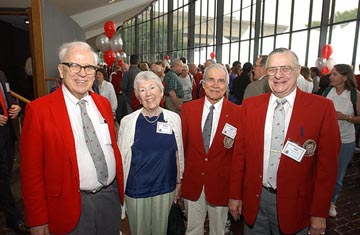 Alumni enjoy a break during the Technology Day program. |
Each year in June, the activities of Tech Reunions and Technology Day give alumni an opportunity to renew connections face-to-face and on campus. Working with Association staff, alumni committees planned a new schedule of activities in FY2003 to accommodate the movement of commencement from its usual Friday date to Monday. This involved the elimination of some activities, the rescheduling of some traditional events, and the introduction of a few innovations. This year's activities were held June 6–8, 2003.
Even with these changes, as well as the external realities of war, disease, and a poor economy, MIT alumni and their families returned to Tech for the weekend in large numbers. Total reunion attendance, although a 7 percent decrease from the previous year, was solidly consistent with the five-year average at 2,600. Some reunion groups achieved the highest attendance in five years, with the 25th reunion showing a 54 percent increase over the five-year average. Stronger than average attendance was also recorded for the 10th, 15th, 40th, and 60th reunion classes.
The biggest changes were to the Technology Day schedule. The Technology Day Committee decided to drop the usual afternoon breakout sessions and give alumni a full day of programming in Kresge Auditorium, allowing the program to feature faculty from each of MIT's five schools. Tech Night at the Pops was moved to Technology Day and was preceded by the Tech Night Dinner that replaced the usual Tech Day Luncheon. As usual, the day started with the Memorial Service in the MIT Chapel.
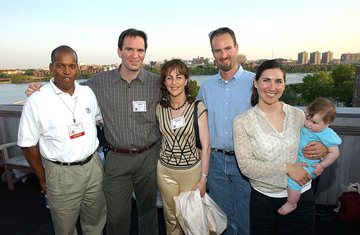 (L to R) R. Robert Wickham '93, Javier Segovia '93, Rosario Sanchez-Gomez, Jonathan Grant, Bethany (Foch) Grant '93 and baby gather at the Class of '93 Welcome Back Event on the Baker House roof. |
The Association made a particular effort to engage recent alumni in many of its reunion programs. Attendance at the young alumni brunch, sponsored for the second year by the 10th reunion class, nearly doubled. The Class of 1993 organized several other special young alumni events on Friday to which they invited other recent classes: an indoor soccer tournament, a Fenway Park tour, a campus art tour, and a walking tour of campus construction projects. Each of these tours was sold-out.
Other Friday activities included on- and off-campus tours, exhibits around campus, department receptions, class dinners, and a popular new Cardinal and Gray dinner dance. The evening was topped off with a new Alumni A Cappella Jam in 10-250. Prereunion events featured the now-traditional Enterprise Forum satellite broadcast program. The year's topic, "What Private Equity Investors Are Looking For," was moderated by Paul Ferri of Matrix Partners and featured a panel of four investors and experienced entrepreneurs.
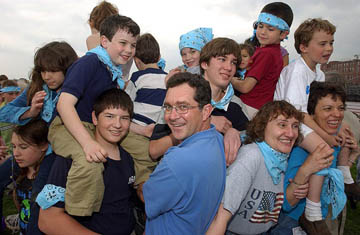 Class of 1978, winners of the Tech Challenge Games, in the Hexagonal Close Packing competition during Tech Reunions 2003. |
The Association hosted its traditional Sunday activities—the annual Reunion Row and the Tech Challenge Games. The annual Techsas Barbecue was replaced by class brunches to provide more time in the shorter schedule for class interaction, and an ice cream social was added at the conclusion of the games. The Class of 1963 defended its title and won the Reunion Row again this year. The Tech Challenge Games were won by the Class of 1978. The Tech Challenge Games Committee voted to name the trophy presented to the winning class the "Bill Hecht '61 Tech Challenge Games Award," and asked me to present the trophy in this and future years.
Each year, the Technology Day symposium assembles a set of compelling speakers from across the Institute, and this year's "Fast Times at MIT: What's New, What's Next—Now What?" was no exception. The Technology Day Committee asked faculty members to speak about their current research, prospects for the future, and ethical dilemmas in their fields. Topics presented were as diverse as transgenic science, cloning, economic globalization, and corporate citizenship. President Vest made opening remarks and the program was moderated by James A. Lash '66, 2002–2003 Alumni Association president.
Speakers representing aspects of each of MIT's five schools included Lawrence J. Vale AR '88, department head and professor of urban studies and planning; Stephen Ansolabehere, professor of political science; Rudolf Jaenisch, professor of biology and member of the Whitehead Institute; Richard M. Locke PO '89, Alvin J. Siteman professor of entrepreneurship and political science at the Sloan School; and Edwin L. Thomas, Morris Cohen professor of materials science and engineering, and director of the MIT Institute for Soldier Nanotechnologies. At the conclusion of the morning portion of the program, Jim Lash presented me with a citation, voted by the Association Board of Directors, in recognition of my 23 years of service as executive vice president and CEO of the Association.
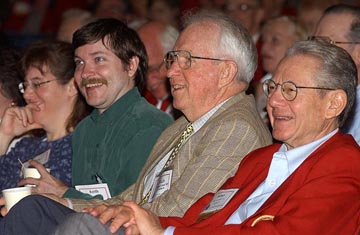 (L to R) Keith MacKay '97, Richard R. Lowe CP '61 and Alan J. Lazarus '53 at the Technology Day program in Kresge Auditorium. |
Featured throughout the weekend was the evolving MIT campus. In addition to the young alumni tour mentioned above, the Evolving Campus presentation in Kresge Little Theatre continued to be popular for the second year in a row. Dean of Architecture Bill Mitchell gave a presentation to the Cardinal and Gray Society, and Ray Stata '57 discussed the Stata Center with the Class of 1948. Several classes planned events at the Zesiger Center and Simmons Hall. The Classes of 1978, 1958, and 1953 organized campus construction and new facilities tours for their reunion groups as well.
Young Alumni and Students
For the past several years, the Association has targeted resources to encourage involvement of our younger alumni and students. It is difficult to connect relational activities undertaken today by students and recent graduates to strong alumni support at some future date. Even so, it is clear that the involved alumni of the future must come from the young alumni and students of today. Investing in that future is at the root of our young alumni and student initiatives.
The Association continued to make strides in developing programming specific to young alumni (undergraduate alumni 0–10 years out and graduate alumni 0–5 years out). These young alumni activities were undertaken as a complement to the Young Alumni Campaign launched by the Alumni Fund in the fall of 2000.
FY2003 was the second year for the Young Alumni Seminar Series, a networking program held in cities in the US with large MIT alumni populations. This past year, seminars were held in New York, Chicago, Los Angeles, and Boston. Nearly 350 recent graduates attended these four programs; in some instances registrations exceeded the spaces available. The centerpiece of each program was a careers discussion led by a panel of local alumni. The series not only involved recent graduates, but also invited 12 first-time alumni presenters to be engaged. From the perspective of both the panelists and the attendees, it was a success.
In other outreach efforts to this population, the Association developed a new "Guide to Alumni Programs and Services" that was sent to all young alumni. This comprehensive guide discusses the range of alumni services and activities MIT provides, and directs interested readers to the Association Web site for more information.
The MIT Travel Program launched a Young Alumni Travel Program with a family-focused trip to Costa Rica this past March. This new program, marketed to younger alumni via email, sold out in two weeks and feedback from participants has been favorable. The travel program will continue to develop offerings for this market.
We also took a strategic look at our student programs and began building a more comprehensive "pre-frosh to senior" program to benefit undergraduate students by building relationships between students and alumni. Association activities this year included:
- Three IAP seminars with alumni panels
- A monthly eNewsletter highlighting Association programs involving students and ways for students to be engaged with alumni
- The development of student Infinite Connection accounts with access to the Online Alumni Directory and the Institute Career Assistance Network, complete with a marketing campaign blitz
Other ongoing Association activities involving relationships with students continued during the year. We worked closely with FSILGs by serving as consultants for their alumni events and communications. The D. Reid Weedon '41 FSILG Alumni Relations Award, managed by the Association, saw an 18 percent increase in applications this year. This past year's award recipient, Phi Beta Epsilon, reported a comprehensive program of alumni outreach including frequent alumni dinners, an improved web site for its alumni, and the first annual Founders Day alumni celebration attended by 120 alumni.
The Association continued to support activities that involve the senior class and other graduating students. The "You Made It" program promotes the Alumni Association as a resource for students when they leave MIT. Its campus marketing drives students to the "You Made It" web site where students can register for the Infinite Connection (IC) services, find out about clubs in communities where they will be after graduation, and vote for class officers. At the close of FY2003, 78 percent of graduating seniors had registered for IC accounts, slightly higher than the 75 percent norm for most classes immediately after graduation.
For many years, the Association has sponsored Senior Dinners at the Gray House, hosted by MIT's official family. Attendance at these dinners has declined over the past several years. In FY2003, the number of dinners was reduced to 5 from a high of 8 just a few years ago, with only about 27 percent of seniors attending. Down from a high of 57 percent a decade ago, participation was the lowest since the program started in 1978. This decline, along with budget constraints, has led the Association to decide not to continue this program in the future. We will plan other ways to recognize the achievement of our graduating seniors.
Several years ago, in an agreement with the Office of the Dean of Students, the Alumni Association began to support senior week activities. This provided students with a first-hand introduction to our reunions programming. This past year, we refocused this program on "signature events" for seniors and their families, including Tech Night at the Pops, Breakfast with the Professors (replacing pancakes with the Vests due to commencement rescheduling conflicts), Senior Week Boston Duck Tour, and a Farewell Reception. More than 25 percent of the class participated in one or more of these events, with attendance at the reception being twice as big as the previous year. Seniors and their families were also invited to participate in Technology Day since it was held prior to commencement.
Another program popular with students is the Student/Alumni Externship Program, an IAP job-shadowing program that places current students with alumni mentors. There were significant increases in student and alumni applications this past year, with 147 students placed with 103 alumni hosts, a 43 percent increase in placements over the previous year.
Our work with graduate students was expanded this past year as well. The Association worked with the Graduate Student Council (GSC) during graduate student orientation and helped with the planning of the GSC's annual career fair. We worked closely with the Graduate Student Office (GSO), supporting focus groups among graduate alumni to help the strategic planning efforts of that office. A brochure for incoming graduate students was developed and distributed. The Association also provided staff support and recent graduate alumni to speak at the GSO's orientation program called Graduate School 101.
Graduate Alumni
Association staff collaborated closely this past year with Dean Isaac Colbert and the Graduate Student Office to engage graduate student-exclusive (GSE) alumni. We initiated graduate alumni events in New York and Northern California, with Dean Colbert as the featured speaker. Both events sold out with simply a "save the date" email, indicating that graduate alumni will respond to events targeted to them as a discrete group. In fact, event evaluations indicated that graduate alumni are interested in increased opportunities to become engaged with the Association and MIT. Dean Colbert also included Association staff on the Graduate Student Collaborative Leadership group among MIT offices that provide services to graduate students.
The Association invested significantly in outreach to graduate alumni, mailing them 10,000 copies of the newly created guide to Association services. Graduate Alumni Program staff participated in the redesign of the Association's web site to refocus web pages from department needs to the needs and interests of alumni. Links on the web site to department pages are still prevalent, but the content focus now is primarily on Association activities.
The Association continued to support departments in their efforts to engage their alumni. Association staff collaborated with four departments to organize professional association events; worked with four other departments to hold department receptions during Tech Reunions; and assisted the Department of Electrical Engineering and Computer Science (100th anniversary) and the Sloan School (50th anniversary) with their anniversary celebrations.
Regional Activities
Regional activities continue to be a cornerstone of the Alumni Association's mission to connect alumni with one another and with MIT. Taking MIT to people where they live is key to achieving the Association's objectives. Alumni continue to be responsive to these activities. In addition to the activities sponsored by the 91 regional MIT clubs worldwide, MIT on the Road, Club Seminars, a new corporate events program, and Enterprise Forum provided other regional activities this past year.
Most regional activity takes place through the MIT clubs whose events are planned largely by club volunteers. Eighteen clubs serve major markets (areas with at least 1,000 alumni, such as Boston, Northern California, Washington, DC) where 57 percent of MIT alumni live. Seventy-three other clubs serve areas with fewer alumni. Area representatives work with staff to plan activities in eight more areas where no formal club structure exists. Based on reports from 75 percent of MIT's clubs, more than 1,250 club events were held around the world in FY2003. In the major markets, 794 were reported, exceeding by more than 20 percent the year's goal of 655. A total of 868 volunteers was also reported, representing a 20 percent increase over goal. Membership in the major markets increased markedly as well to 6,149. Unlike regional programs in some of our peer institutions, our alumni clubs are thriving.
Started in FY2002, corporate events have allowed us to expand regional activities to engage more alumni at the local level. Events held this past year at IBM, Microsoft, Chevron, and WorldBank were sponsored by key MIT alumni who are officers in these companies. All MIT alumni in the company were invited to network with one another at the events, allowing us to reach alumni who are not generally involved in other Association activities. Because this program is still new, we will continue to experiment with the format to determine what will be most successful.
Infinite Connection
Infinite Connection services continued to enjoy high popularity with alumni. The Infinite Connection is the password-protected portion of our Association web site. This past year, it included Email Forwarding for Life, the Online Alumni Directory, alumni email lists, and services for alumni volunteers, including Web sites for many alumni groups.
The number of alumni registered for the Infinite Connection (IC) has shown a steady increase over the past five years, with nearly 54,000 alumni registered at the end of FY2003. The year's campaign to register students yielded nearly 80 percent of the senior class, about 30 percent of each of the other undergraduate classes, and 20 percent of the graduate students who do not have a previous MIT degree. Usage increased steadily during the year, although most of the usage is by 35,000–45,000 unique users each month who login frequently. A total of over 700,000 visits and nearly 5 million page visits were recorded.
Email Forwarding for Life (EFL) continues to be the most popular service of the IC. All registered users have a forwarding email address. It is hard to know how many of them use the services routinely, but we do know anecdotally that many alumni use this address for their professional email address. This is demonstrated by the fact that we forwarded approximately 5,000,000 email messages per month in FY2003. Recently, we forwarded our 100,000,000th email message. This traffic volume has required us to increase the server capacity of the program.
Usage of the Online Alumni Directory (OAD) increased dramatically this past year, from just over 150,000 searches in FY2002 to over 350,000 searches in FY2003. An increasingly important feature of the OAD is the capacity for alumni to update their own personal information records. Many are doing just that each month, helping to improve the accuracy of the alumni records database.
With the addition of the Class of 1959 web site, all classes from 1950 and younger maintained a web site served by the Association server. Clubs and other alumni groups also maintained web sites with the Association. The Association supported alumni email lists for official alumni groups as well as ad hoc groups who used this service to find alumni with similar interests.
Alumni Career Services
The Alumni Association has a limited set of career services for alumni, all of which are web based. They include networking opportunities supported by the Institute Career Assistance Network, available to both students and alumni, a job bulletin board, and eProNet.
The Institute Career Assistance Network (ICAN) is the primary alumni career service resource. This past year, we continued to enhance the marketing of ICAN to students and alumni. We focused on recruiting additional alumni advisors and saw them increase to 2,602, more than a 10 percent increase over the previous year. Using email and print marketing, we increased usage to record highs, with 713 unique student users and 2,861 alumni searchers.
More than 1,000 jobs were posted on the alumni-to-alumni job bulletin board. The site received more than 100,000 hits in FY2003, a sure sign of the flagging economy and the difficulty our alumni are experiencing in finding work after layoffs.
We continued to work with the external firm Experience, who provides the product eProNet. FY2003 saw 18,290 registered MIT alumni users of eProNet, a system where alumni can post a resume, conduct online career assessments, and use a variety of other online career assistance tools.
Parents Association
Family Weekend, held on October 18–20, 2002, featured Professor Wolfgang Ketterle, who won the Nobel Prize for physics in 2001, and Professor Robert Langer CH '74 who won the 2003 Draper Prize for engineering innovation. Parents went to classes, visited labs, and attended student performances. Eighteen departments held receptions to greet parents and 24 living groups also welcomed parents.
The Parents Association, in cooperation with volunteer Parent Connectors, assisted in facilitating over 30 send-off events in local communities and made 132 welcome calls to incoming students and their parents. We hosted well-attended parent events in three locations—New York, Northern California, and Southern California. Communication with parents included a letter from President Vest, a Parents Association brochure with information about student life at MIT, two issues of Parents News, and numerous email messages in response to inquiries sent to mykidis@mit.edu.
This past year, the Parents Association had an increased presence in a number of campus events including Freshman Orientation and Campus Preview Weekend. Relationships were strengthened through work with other MIT departments that interact with parents, such as Campus Dining; MIT Libraries; the Disabilities Office; the Department of Athletics, Physical Education, and Recreation; and the Admissions Office. We also had the opportunity to invite a current parent to sit on the newly formed Campus Dining Board as a representative of the Parents Association.
Other Alumni Groups and Activities
Beginning with the organization of the Association of MIT Alumnae (AMITA) over 100 years ago, the Association has supported the efforts of special constituency groups. Today, the Black Alumni of MIT (BAMIT), the Chinese Alumni of MIT (CAMIT), the MIT Arab Alumni Association (MITAAA), and the Bisexual, Gay, and Lesbian Alumni (BGALA) are all active organizations, supporting networking activities among their members and with students; holding events for their members; hosting web sites and email lists; and raising funds for MIT. AMITA continued to host networking events regionally and to encourage female high school students to consider careers in science and engineering. BAMIT held their most successful exit reception ever for graduating students and their parents on the Sunday before commencement with more than 250 students, alumni, and guests in attendance. CAMIT held events in Boston and New York City for Chinese alumni. The MITAAA sponsored their fourth annual Pan Arab Conference in Dubai. Originally scheduled at the start of the war in Iraq, the conference, rescheduled to June, was well attended and turned out to be a positive experience for all involved. BGALA hosted monthly dinners, an IAP event, and the Lavender Graduation and Reunion Reception for graduates and reunion attendees.
The Association continued to work closely with the Department of Athletics, Physical Education, and Recreation (DAPER) on fundraising from athletics alumni. The department has been expanding its alumni relations programs and organized an alumni advisory group. Association staff worked with DAPER to coordinate these efforts and better understand the department's needs.
The Association continued to provide support for fundraising and alumni relations for various campus religious groups. We have encouraged these groups to be involved in Tech Reunions and Family Weekend. This past year, 13 religious services were listed in the Family Weekend program and four events were listed in the Tech Reunions guide.
Participate
The substantive engagement of MIT alumni in service to MIT is at the heart of the mission of the Association. MIT alumni volunteers plan reunion and regional events, make Alumni Fund solicitations, interview prospective students, participate in the governance of the Association and MIT, and much more. More alumni give evidence of their commitment to MIT by making a gift to the Alumni Fund than in any other single way. The involvement of alumni who give their time as well as their money to MIT helps to sustain the excellence of the Institute.
Volunteer Leadership in Governance
The Alumni Association Board of Directors, the governing body of the Association, was led this past year by 2002–2003 Association president James A. Lash '66. Under Jim's leadership, the Board and staff focused attention on sharpening the governance processes of the Association. We began a systematic review of Association policies and procedures. The staff developed a set of performance measures that continue to be refined.
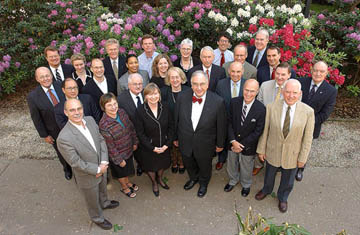 The FY2003 Board of Directors of the MIT Alumni Association. (L to R) Row 1: Rafael L. Bras '72, Sandra W. Morgan GM '73, Richard I. Bergman '55, Elizabeth A. Garvin HM, Cynthia H. Skier '74, William J. Hecht '61, William L. Maini '51, Lester A. Gimpelson '57, Gregory E. Moore '73, Richard R. Lowe CP '61, Bruce Blanchard '57. Row 2: Kenneth Wang '71, Jonathan M. Goldstein '83, Chiquita V. White '85, Monica Ellis '91, James A. Lash '66, Paul Rudovsky '66, John D. Chisholm '76. Row 3: Scott P. Marks, Jr. '68, Stephen J. Derezinski, III '90, Annalisa L. Weigel '94, L. Robert Johnson '63, Matthew K. Haggerty '83, Diana Strange HM, Marc J. Chelemer '81, R. Gregory Turner '74. |
The Board initiated the first of what will become regular strategic reviews of Association activity. It began this review process by examining the MIT Travel Program and Class Giving. Ad hoc committees were led by Board members and included many volunteers who were not members of the Board. Richard Lowe CP '61 chaired the travel program review committee and Greg Turner '74 was chair of the class giving group. The committees commended the Association staff on running outstanding programs. They proposed reducing the travel program's focus on revenue and putting emphasis on increasing the MIT flavor of its trips. The class giving review noted the staff's emphasis on tactics and recommended more attention to strategy. The committees presented their recommendations at the March board meeting and participated in a review of the process at the June meeting. The experience of these committees will be factored into the next iteration of the process during FY2004.
Jim Lash visited alumni around the world in places as far flung as Mexico, California, Washington, DC, and Dubai. Wherever he went, Jim represented MIT with distinction. The presentation he developed about MIT's history and its future was given during these visits, delivered at the Alumni Leadership Conference, and posted on the Association web site.
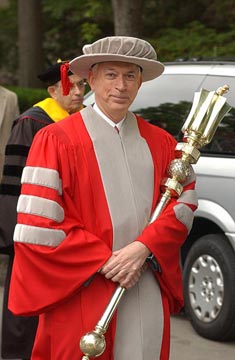 James A. Lash '66, Alumni Association, led the 2003 Commencement processional. |
Jim performed an extraordinary service to MIT and the Association through his dedicated leadership. I have served with many people in the role of Association president and Jim ranks highly among them. He brought a deep affection and commitment to MIT, along with a gift for asking challenging questions and a desire to make the Association more effective. After I announced my intention to step down, Jim invested heavily in enabling the orderly transition of the Association leadership during the final quarter of the year.
The Board of Directors is an exemplar of the many ways alumni are involved at MIT. This past year, we recorded nearly 6,400 volunteers, 78 percent men and 22 percent women. Among them were 834 class officers, 839 club officers, 2,198 members of the Educational Council, and 2,948 ICAN career advisors. Over half had been alumni since 1980. Many also served in multiple volunteer capacities. An increasing number of them—27 percent in FY2003—held a graduate degree as their first MIT degree.
Alumni Leadership Conference
The annual Alumni Leadership Conference (ALC), celebrating the tremendous commitment of these men and women, was held September 20–21, 2002. More than 400 alumni volunteers and their guests, the largest crowd ever, gathered to reconnect, to learn, and to be recognized for their achievements on behalf of MIT.
The centerpiece of the Saturday morning plenary session was a presentation by President Vest on "The Evolving MIT Campus," followed by a panel discussion by Provost Robert Brown, Educational Council director Stuart Schmill '86, and Chancellor Phillip Clay CP '75. Scott P. Marks, Jr. '68, chair of the Alumni Fund Board, presented the annual report of the Fund and Steven Dare, director of Resource Development, gave a capital campaign update. Jim Lash concluded the morning session with a talk on "Aligning the Alumni Association's Objectives with the Institute's Objectives."
The lineup of conference meetings and workshops included a special luncheon on Friday for Alumni Advisory Committee members, Advisory Committee meetings, an orientation workshop for first time volunteers, and a workshop on new ideas for experienced volunteers. Specifically focused workshops for class, club, Educational Council, and independent living group volunteers were held on Saturday afternoon.
At the ALC luncheon, Jim Lash presented Association awards and commendations for the hard work of 25 individual alumni and five groups. These awards were recommended by the Awards Committee and voted by the Board of Directors at the June 2002 meeting.
Bronze Beaver Award for distinguished service to MIT, the highest Association recognition honor:
- Alexander V. d'Arbeloff '49
- Brit d'Arbeloff ME '61
- Malcolm Green '50
- Emmanuel Ikpo OE '83
- Ronald A. Kurtz '54
Harold E. Lobdell '17 Distinguished Service Award for sustained alumni relations service of special depth:
- Richard I. Bergman '55
- Robert W. Blake '41
- Michael D. D. Clarke '92
- Jon L. Ganger '50
- Shaheen Husain GM '81
- Gurumurthy Kalyanaram GM '89
- Frank J. H. Liu '66
- Joseph W. Marcello '52
- Sandra W. Morgan GM '83
- Cordelia M. Price '78
- Mark Y. D. Wang '87
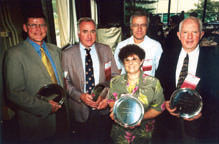 (L to R) Walter C. Price, Jr. '70, Peter A. Klock '65, Mary Anne Rivet '70, Elisha W. Erb '61, and Richard R. Lowe CP'61 received Morgan Awards at the Alumni Leadership Conference Awards luncheon. |
George B. Morgan '20 Award for excellence in service to the Educational Council:
- Elisha W. Erb '61
- Peter A. Klock '65
- Richard R. Lowe MCP '61
- Walter C. Price, Jr. '70
- Mary Anne Rivet '70
Henry B. Kane '24 Award for exceptional fundraising service and accomplishment:
- Frederick D. Ezekiel '51
- Ernest R. Kaswell '39
- Joseph Harrington III '61
- Rhonda E. Peck '82
Presidential Citation Award given to alumni volunteer groups for distinguished service:
- Class of 2001 Senior Gift Committee
- Department of Ocean Engineering—for 100th Anniversary Event
- MIT Arab Alumni Association—for Pan Arab Conferences
- MIT Club of Northern California—for Spotlight MIT 2001 Event
- MIT Club of South Texas—for 75th Anniversary Event
Honorary Membership(presented at the Technology Day luncheon, June 3, 2002):
- Elizabeth A. Garvin
- Margery Resnick
- Rosalind H. Williams
A new event this year was a Friday evening reception and dinner for these award winners and their guests. One award winner enjoyed the dinner so much that he made a gift to ensure the continuation of this practice.
National Selection Committee
It is the responsibility of the National Selection Committee (NSC) to select the officers of the Alumni Association and to name a slate of three alumni nominees for election to the MIT Corporation for three-year terms. Harris Weinstein '56, past president of the Association, chaired the NSC, whose members are elected at large by all alumni from eleven geographic districts. Members of the NSC this past year included: Harris Weinstein '56 (Chair), James S. Banks '76, Bruce A. Blomstrom '59, Kenneth S. Brock '48, Lisa C. Egbuonu-Davis '79, Robert V. Ferrara '67, Walter P. Frey '56, James H. Koenig '87, Bernard Loyd '83, Cordelia M. Price '78, K. Anne Street '69, and Yenwith K. Whitney '49.
The National Selection Committee has named the following alumni to MIT and Association positions for the year beginning July 1, 2003 (FY2004):
| MIT Corporation for five-year terms | Claude L. Gerstle '68 |
| Gregory E. Moore '73 | |
| Arthur J. Samberg '62 | |
| Association president FY2004 | Paula J. Olsiewski CM '79 |
| Association president-selected to serve as president FY2005 | Linda C. Sharpe '69 |
| Association vice presidents for two-year terms | Robert L. Blumberg '64 |
| Robert V. Ferrara '67 | |
| Association district directors for two-year terms | Allan C. Schell '55 |
| Jeffrey Weissman '69 | |
| David A. Dobos '77 | |
| Thomas C. Gooch '77 | |
| Mark Y. D. Wang '87 | |
| Association young alumni representative for two-year term | R. Robert Wickham '93 |
National Boards and Committees
More than 100 alumni served as members of Association national boards and committees in FY2003, including the Alumni Association Board of Directors, chaired by James A. Lash '66, president. Committees were led by the following volunteers: Richard I. Bergman '55, Audit and Budget Committee; Scott P. Marks '68, Alumni Fund Board; Thomas C. Davis '84, Alumni Fund Goals Committee; Richard A. Jacobs '56, Awards Committee; James A. Champy '63, Committee on Nominations for Corporation Visiting Committees; Matthew Haggerty '83, Enterprise Forum Board; Harris Weinstein '56, National Selection Committee; and Kimberly-Ann Francis '78, Technology Day Committee.
The Board also appointed several ad hoc committees this past year. Program review committees were led by Richard Lowe CP '61 (MIT Travel Program) and Greg Turner '74 (Class Giving). Scott Marks was named chair of the Credit Card Committee to negotiate a new bank card agreement for the MIT Alumni Association credit card.
The Alumni Fund and The Parents Fund
In a year characterized by a continued slow economy, a war in Iraq, and the threat of a world epidemic from SARS, alumni, parents, and friends continued strong support of MIT, even setting a few records along the way. More than 29,000 alumni donors contributed to the fund, the largest number in the past three years, exceeding our goal by 138 donors. First time donors reached 2,005, exceeding our goal by 18 percent. Graduate alumni participation began a turnaround after a slump for several years, reaching the 11,000 donor mark, an increase of 6 percent over the previous year. The Parents Fund set a donor record with 1,490 donors. We are very encouraged by this sustained support by MIT alumni and parents even in difficult times.
Our dollar results are not quite as strong, no doubt reflecting the economy. Even so, gifts to the Alumni Fund this past year were $29.3 million, and Parents Fund gifts of $507,000 exceeded their $500,000 goal. Matching gifts were the second highest in five years and increased by 6 percent over FY2002.
FY2003 Alumni Fund Goals and Results
| Criteria | FY2003 Results |
FY2002 Results |
FY2002/2003 Results |
FY2003 Goals |
| Total Alumni Fund | $29,289,802 |
$30,021,480 |
($731,677) |
$30,000,000 |
| Undergraduate | ||||
| # Donors to Fund | 18,157 |
18,311 |
(154) |
18,500 |
| # Donors > $500 | 3,373 |
3,397 |
(24) |
3,400 |
| % Donors > $500 | 18.6% |
18.6% |
0 |
18.4% |
| # First-time donors | 945 |
1,019 |
(74) |
900 |
| Graduate Degree-Only | ||||
| # Donors to Fund | 11,001 |
10,315 |
686 |
10,500 |
| # Donors > $500 | 1,292 |
1,274 |
18 |
1,300 |
| % Donors > $500 | 11.7% |
12.4% |
(0.7) |
12.4% |
| # First-time donors | 1,060 |
552 |
508 |
750 |
| Total | ||||
| # Donors to Fund | 29,158 |
28,626 |
532 |
29,000 |
| # Donors > $500 | 4,665 |
4,671 |
(6) |
4,700 |
| % Donors > $500 | 16.0% |
16.3% |
(0.3) |
16.2% |
| # First-time donors | 2,005 |
1,571 |
434 |
1,650 |
| Total Giving > $2,000 | ||||
| # Donors > $2,000 | 1,296 |
1,262 |
34 |
1,300 |
| % Donors > $2,000 | 4.4% |
4.4% |
0 |
4.5% |
| Total Giving > $5,000 | ||||
| # Donors > $5,000 | 683 |
678 |
5 |
675 |
| % Donors > $5,000 | 2.3% |
2.4% |
0 |
2.3% |
Scott P. Marks, Jr. '68, 2002–2003 Alumni Fund Board chair, led more than 300 Fund volunteers in gaining this success. The Fund Board focused attention on participation. There was a strong message throughout all our solicitations that "you and your gift matter" to MIT. The Fund Board encouraged staff and volunteers to experiment with the Internet, to strengthen the matching gift program, to monitor pledge fulfillment, and to implement an automated phoning system.
New or enhanced fundraising initiatives this year included:
- December Fund Record solicitation to GSE alumni
- Class agent holiday card
- Young alumni solicitation
- New year's resolution mailing to loyal sometime donors
- Internet- and web-based initiatives
Increased web leveraging included targeting an electronic solicitation at the end of FY2003 using a combination email and "flash" presentation, as well as a special email challenge issued by Scott Marks to young alumni for a one-week period that produced a gift in the first fifteen minutes after it hit the Internet! The Association launched a new online giving form this past spring that provided interactive gift designation, multi-year pledging, shared gift credit options for MIT couples, and a matching gift lookup feature.
The improved matching gift results, $1.63 million, reflect an effort to strengthen this program by going after the best potential matching gift donors, reminders to donors to submit claims, company check presentation photo opportunities at several corporate events, three sets of personalized communications, and improvements in our record keeping.
A significant process improvement in the phonathon program was the purchase and launch of a new automated phonathon system, CampusCall from RuffaloCODY. Staff and our student Tech Callers were trained to use the system in the fall. Association technical staff worked with the vendor to enable automatic transmission of solicitation results directly to the alumni records database, saving hours of staff time on entry of pledge information and address updates. The automatic system also allows callers to place more calls and reach more alumni. This system was used with student callers.
This CampusCALL automated telemarketing system provided data previously unavailable for tracking the program. Automation of a portion of our calling has had a marked effect on efficiency. A total of 3,971 gifts and pledges, 6,043 address updates, and 11,176 interactions other than gifts or pledges were automatically uploaded into the Advance database. This saved an estimated 146 hours of data entry staff time. The program was in operation for less than 9 months during the year.
This past year, 29 percent of all Alumni Fund participants pledged their gifts in response to a phone call through this new system or from more than 600 volunteer callers in regional phonathons and on campus. These callers reached more than 40 percent of our alumni, resulting in pledges of nearly $1 million. Phonathons continue to be an important tool for maintaining Fund participation and encouraging gift upgrading.
The second year of a new 30-60-90 day pledge reminder system yielded a 5 percent improvement in one-year pledge fulfillment and a 10 percent improvement in fulfillment of multi-year pledges.
More graduate student-exclusive (GSE) alumni donors gave this past year than in the previous two years, 11,001 donors. A mailing in the fall from department heads reached the 47 percent of our alumni that are GSE. Staff also supported department phonathons that showed slightly increased donor and dollar results over the previous year. Gifts raised from GSE alumni totaled $6.2 million, 25 percent of the gifts in the Fund from alumni.
The Parents Fund, led by Simon and Eileen Chow P'03, added 10 members to its fundraising committee. The 28 members of this committee made a significant impact on our outreach to parents. Each committee member made 10 calls resulting in over 270 peer-to-peer telephone solicitations, surely a large factor in the record donor result of 1,490 parent contributors. The dollar result of $506,891 was a 35 percent increase over the FY2002 figure.
Class Giving
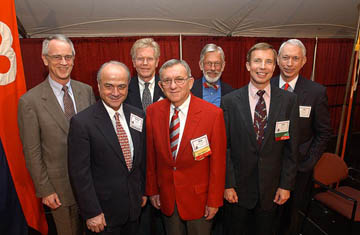 Reunion classes presented gifts at Technology Day Dinner. (L to R) Chuck Vest HM, MIT President; Kenan E. Sahin '63, Honorary Chair 40th Reunion Gift Committee; L. Robert Johnson '63, 40th Reunion Gift Chair; Richard P. Simmons '53 and Robert R. Piper '53, Co-chairs for 50th Reunion Gift Committee; John W. Jarve '78, Chair for 25th Reunion Gift Committee; and James A. Lash '66, President, Alumni Association. |
The major emphasis of Class Giving is the Reunion Gift Program. Also included are the Young Alumni Campaign, the Senior Gift Program, and the Class Agent Program.
Reunion Giving
Reunion gifts this year totaled an unprecedented $179,779,998, led by the generous campaign gift of $100,000,000 by Kenan Sahin '63. Six reunion classes presented record breaking gifts (see chart below) and the Class of 1963's 71 percent participation broke the 40th reunion participation record set by the Class of 1949 fourteen years ago. This outstanding record achieved by all reunion classes is the result of the hard work of 13 reunion gift committees and 164 volunteers, and a reflection of the successful Campaign for MIT. Reunion giving staff worked closely with Resource Development staff to coordinate the solicitation of major prospects who are in reunion classes and often who serve as reunion gift volunteers.
In FY2003, reunion giving staff partnered with the Friends of MIT Crew by recruiting crew representatives from each of the reunion classes to encourage giving to the Friends of MIT Crew. Results were promising and we plan to continue to refine and strengthen this approach in the coming year.
Reunion Gift Results FY2003*
| Class Year | Reunion Year | Gift Total | Participation |
| 1923 | 80 |
$4,591,855 |
24% |
| 1928 | 75 |
$9,702,392 |
46% |
| 1933 | 70 |
$5,019,790 |
60% |
| 1938 | 65 |
$4,516,133 |
79% |
| 1943 | 60 |
$3,694,740 |
72% |
| 1948 | 55 |
$3,379,994 |
55% |
| 1953 | 50 |
$25,419,972 |
63% |
| 1958 | 45 |
$3,531,299 |
50% |
| 1963 | 40 |
$111,779,328 |
71% |
| 1968 | 35 |
$474,167 |
48% |
| 1973 | 30 |
$803,301 |
44% |
| 1978 | 25 |
$6,265,951 |
65% |
| 1983 | 20 |
$383,127 |
38% |
| 1988 | 15 |
$71,140 |
32% |
| 1993 | 10 |
$47,532 |
25% |
| 1998 | 5 |
$22,965 |
23% |
| 2003 | Senior
Gift |
$29,312 |
25% |
| Total | $179,732,998 |
*Bold numbers indicate record-breaking reunion gifts.
The Young Alumni Campaign
At the start of MIT's capital campaign, the Alumni Fund Board appointed a young alumni campaign committee to make sure that recent undergraduate alumni would be included in the campaign. The focus of this campaign is on participation with a theme of "Participate. Designate. Make a difference." Young alumni are considered those who are 0–10 years out from graduation. This past year, participation among this group was sustained at 23 percent and nearly 800 made their first gift to MIT.
The Young Alumni Campaign Committee began a concerted effort this year to track renewals of this first-time donor cohort. This renewal rate had dropped as low as 38 percent in FY2001 from 55 percent in FY1994. The committee held its second annual "thankathon" in which 14 callers reached 774 young alumni donors and thanked them for their gift, a 200 percent increase over the first year of the effort. Class agents were also asked to take special note of first-time donors when they sent thank you letters. By the end of FY2003, the renewal rate was back up to 40 percent and the committee hopes to continue to see improvement in the participation of these new donors.
To encourage young alumni participation, Scott Marks, chair of the Fund Board, offered a special one-week email challenge from June 4–11. This brought in 31 first-time gifts and generated nearly $5,000 from young alumni.
Senior Gift
The Fibonacci Challenge, funded by James A. Lash '66, was used effectively again with the senior class, helping them to achieve 25 percent participation and to raise $29,312 (without Lash's $4,500 in matching funds). This effort was led by Senior Gift Chair Hareesh Nair and a committee of 12 other seniors.
Class Agent Program
The Class Agent Program raised $125,474 from 425 donors, a donor increase of 53 percent over the previous year. This past year, the program incorporated a new approach to solicitations, streamlining the involvement of class agents and yielding strong response rates. A primary activity of class agents is stewardship of class gifts.
The MIT Capital Campaign
The Association continues to collaborate with Resource Development to solicit gifts for The Campaign for MIT, to manage jointly the Giving to MIT web site, and to leverage other communications tools across the units. The Alumni Fund reinforces to our broader alumni audience the goals of the campaign and focuses on campaign priorities across its fundraising efforts. For example, solicitations to graduate alumni this year used materials created by Resource Development to encourage giving to graduate student fellowships.
The Alumni Fund Board set a campaign goal of $230 million in cumulative annual gifts, which still stands as the largest "gift" to the Campaign. We continue to be in the range for achieving that goal, with total campaign gifts in the Alumni Fund after four years, standing at $182.7 million.
Services in Support of Volunteers
The work of our volunteers is accomplished in partnership with Association staff. We have continued to expand the Ad Hoc Advisory Committees, groups of alumni recruited by staff to help the Association improve alumni relations program performance and volunteer support. This past year, the Young Alumni Advisory Committee and the Graduate Alumni Advisory Committee held their first meetings. Ongoing groups included the Clubs Advisory Committee and the Travel Program Advisory Committee.
We continued to improve the services we offer volunteers. A major achievement was the development and implementation of SmarTrans on time and on budget. Improvements also included special emphasis in the Clubs Program on volunteer training, support of online balloting, and online registration for on-campus events. We also launched a volunteer tracking system in our Advance database.
SmarTrans
This past year, the Association implemented a system to offer simple event registration and dues collection for clubs and other alumni groups called "SmarTrans." Volunteers and staff are now able to enter information online, and produce event registration data and dues collection forms. Registrants can get event information online and sign-up when convenient. Club and class members can pay dues online. Both volunteers and Association staff can view registration and dues reports online. Credit card payments are validated and processed immediately. Training for this new system began in early May and the application went live on June 16. Twelve alumni clubs were trained to use this system as well as internal Association staff teams. We now have the capability to capture accurate records of club membership and participation in events, to receive address changes, and to broaden the suite of services offered to alumni volunteers.
Volunteer Training
The Association gave special emphasis to volunteer training in FY2003, assisting alumni groups to "raise the bar" in terms of serving MIT alumni in their areas and building a stronger infrastructure. The staff Volunteer Management Subcommittee worked on three innovative projects: the Volunteer Management Handbook and staff training; the redesign of the volunteer portion of the Alumni Association Web site; and the creation of the new Volunteer Honor Role of Service. These projects focused on supporting and enhancing the work of our staff and of our alumni volunteers with outstanding results.
We conducted our first videoconference training with the clubs of Atlanta and Northeast Ohio using MIT's conferencing services. We expect to continue to "meet" with club volunteers in other regions, including some overseas clubs, using video conferencing.
Online Balloting
The Association supported online balloting for reunion classes, the undergraduate senior class, and the Corporation Young Alumni Ballot. The National Selection Committee ballot was redesigned to allow for online voting as well. Other objectives of this redesign were to improve alumni understanding of the committee and of the voting process, to increase voter participation, and to reduce costs. A record-breaking 4,451 alumni voted in the election. More alumni voted online (3,858) than had voted in this election in ten years. Alumni feedback on the electronic ballot was favorable and constructive.
Explore
Alumni want the opportunity to explore the research and learning community at MIT. When we ask alumni what that want from MIT, they tell us they want to be up to date on the latest research; they like interaction with students to learn what student life is like today; and they are eager to know the current campus news. The Association has developed programs that help alumni explore MIT, opportunities for alumni to interact with MIT faculty and students in face-to-face encounters, and ways to learn about MIT online.
Through MIT on the Road, the Association brought faculty and alumni together in day-long symposia that highlighted several areas of research and teaching at MIT. Through the Clubs Seminar Program, the Association sent alumni, faculty, and MIT administrators to speak to clubs all over the world. Through the MIT Travel Program, alumni met other alumni interested in the same things they enjoy and traveled with MIT faculty. In MIT classrooms, alumni interacted with students and faculty to help in the education of current students. Online, alumni explored MIT through the openDOOR Web magazine; could see What Matters to other alumni; watched campus lectures by world-renowned speakers on MIT World; and much more.
MIT On the Road
MIT on the Road (MOTR) held events in three cities this year: Detroit, San Diego, and Washington, DC. With a combined total of 372 registrants, the program achieved its second highest attendance since it began six years ago. During the life of MOTR, nearly 1,350 alumni attended 20 day-long symposia featuring MIT faculty members. The program reached all the major club areas in the US, as well as Paris and Lisbon. It was especially successful as a cultivation tool for donors during the current capital campaign. This past year was the final year of MOTR in its current format. We will keep the name and continue with the same quality at reduced cost.
Club Seminars
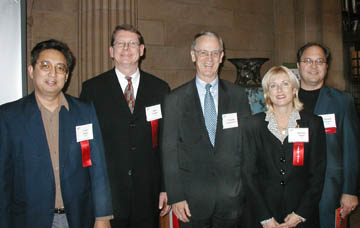 President Charles M. Vest HM attends a Club of Minnesota event. |
Club Seminars continued to be a popular regional activity among alumni. Sponsored by alumni clubs or affinity groups, seminars featured presentations by MIT faculty, senior administrators, or fellow alumni. FY2003 was a strong year for the seminars program, with 55 clubs and 3 affinity groups sponsoring 109 events, more than in any year since the program started in FY1999. A total of 6,570 people attended these events for an average of 59 attendees per event.
MIT Enterprise Forum
Celebrating its 25th year, the MIT Enterprise Forum significantly increased attendance figures both for its Satellite Broadcast Series, produced at MIT, and at events held across the world at its 24 chapter locations. The broadcasts drew nearly 5,000 attendees (roughly 1,050 alumni) to a total of 80 locations around North America and the world. Each of the 24 Forum chapters also presented one or more events per month. Through the efforts of nearly 500 volunteer leaders, many of them MIT alumni, nearly 300 events with over 30,000 attendees were held throughout the year.
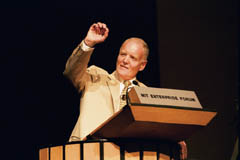 Professor Lester Thurow HM spoke at the first Enterprise Forum satellite broadcast program, "Entrepreneurship in a Global Economy." |
The past year's satellite broadcasts, conducted before a live audience on the MIT campus and transmitted to Forum chapters and MIT Clubs, took place on September 18, 2002, January 23, 2003, and June 5, 2003. The first broadcast, entitled "Entrepreneurship in a Global Economy," featured Sloan School professor of economics Lester Thurow HM and moderator Bill Hecht '61, executive vice president and CEO of the MIT Alumni Association. Next was "Solving the Weakest Link: Sales," moderated by Howard Anderson, founder and chairman of the Yankee Group, and featuring Ken Morse '68, managing director of the MIT Entrepreneurship Center, and Tim Kraskey, managing director of YankeeTek Ventures. The final broadcast, entitled "What Private Equity Investors are Looking For," was moderated by Paul Ferri of Matrix Partners and featured a panel composed of Noubar Afeyan, Ph.D. CH '87, senior managing director and CEO of Flagship Ventures; Alec Dingee '52, co-founder and director of the MIT Venture Mentoring Service; Helen Greiner '89, cofounder and president of iRobot Corporation; and Allan Wallack, formerly CEO and president of Spring Tide Networks.
Alumni Engagement in the Education of MIT Students
The Council on Educational Technology launched an experiment several years ago to involve alumni in the education of MIT students. Over the years, the Association has worked with the Office of Career Services and Preprofessional Advising, the School of Engineering, and a few other faculty to identify and recruit alumni for these kinds of activities.
This past year, the Office of Career Services and Preprofessional Advising engaged alumni in a number of activities. Many major corporations sent alumni back to MIT as their recruiters. In cooperation with the Alumni Association, a reception was held last year, following a career fair, with some of these alumni and MIT students. The career office recruited 25 graduate degree-only alumni to be part of an all-day symposium for graduate students in March. The Freshman/Alumni Summer Internship Program (F/ASIP), managed by the career office, reported many alumni participated in their on-campus training for students, and other alumni served as hosts during summer internships.
The School of Engineering has renewed its emphasis on engineering practice. One prominent initiative this year was the Undergraduate Practice Opportunities Program (UPOP) for sophomore engineering students. This program, managed by engineering staff funded through the Deshpande Center, invited alumni to participate as industry professionals in IAP sessions and also to sponsor internships during the summer.
In the fall, the Mission 2006 subject (12.000 Solving Complex Problems) focused on research in the rainforest with nearly 50 alumni mentors helping students develop their projects. During IAP, students traveled to the Amazon where they met with MIT alumni who were working in universities and industry in Brazil. In EECS, 6.002 Circuits and Electronics used 18 alumni tutors with small groups of students to test a case study model with engineering students similar to that used in the Harvard Medical School.
The School of Engineering is developing Knowledge Updates, short web-based subjects on topics of current interest. The Association facilitated a survey of alumni to provide market information for the project. Other alumni served as beta testers for the first offering.
To facilitate these and other involvements of alumni with students and faculty, the Association helped identify and recruit alumni by using the ICAN network, personal knowledge of alumni by some of the experienced staff, and a volunteer jobs posting service online. The Tech Connection email newsletter sent monthly to nearly 70,000 alumni also became a valuable tool for recruiting interested alumni. We also tracked the involvement of alumni in these activities in our database.
Exploring MIT Online
Our web magazine openDOOR went from being a monthly publication to bimonthly this year. This publication featured an aspect of MIT that is of current public interest. The following headlines from this year illustrate the breadth covered by this publication: "Explore Earth Systems," "Making Money Work," "History and Culture," "Energy Futures," "The Built Environment," and, what has become an annual June feature, "Site Seeing: the Class of 2003." Each issue featured expertise at MIT, comments by faculty and often alumni, and opportunities for reader feedback.
Another popular online feature is our What Matters opinion column, written by alumni. We carried on the tradition of engaging alumni in dialog with a pressing national issue—in FY2002, the events of September 11; this past year, the war in Iraq. We received a wide variety of opinions as feedback to "Alternatives to War in Iraq," a column written by Randall Caroline Forsbert, PhD '97. We published the feedback and encouraged alumni to continue to engage in a dialog on the topic. We posted on the Web site an archive of What Matters columns that ranged from photos taken in Cambodia, to a student's reflections on Martin Luther King's dream, to soldier nanotechnology and affordable sustainable housing.
For the past two years, the Association partnered with MIT World, now a service housed in the School of Engineering Professional Education Programs unit. In its video archive, MIT World posted over 50 lectures given on campus by internationally known speakers and MIT faculty. These videos were available to the public through the MIT World web site. The Association highlighted a new video in each of its email newsletters and on its web site. When a new posting went out to alumni, we saw an immediate response in traffic to the MIT World web site. The Association will not sponsor this program in FY2004, but we will continue to market MIT World to alumni.
Every day the Association web site was updated with current news of research at MIT, as well as other campus developments of interest to alumni. In addition, our web site directed alumni to the MIT events calendar; to MIT publications such as Technology Review, Tech Talk, Spectrum, and The Tech; to MIT Library Resources for alumni; and to many other MIT web sites related to the features described above.
MIT Travel Program
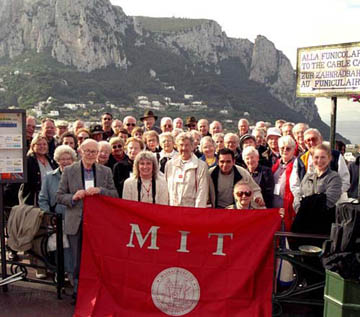 MIT alumni group on Travel Program trip to Capri in November 2003. Alumni Campus Abroad in Sorrento, hosted by professor emeritus S. Jay Keyser HM. |
During FY2003, the MIT Travel Program offered 36 trips to alumni travelers, including a Cardinal and Gray trip to Nova Scotia and the Class of 1950's trip to France. MIT faculty accompanied alumni on 13 of these trips.
The travel program has withstood two difficult travel years. The events of September 11, 2001, affected travel in FY2002 and, in FY2003, the weak economy, the war in Iraq, and the SARS epidemic discouraged many people from traveling. In fact one alumni trip planned to China during the height of the SARS scare had to be cancelled. Even so, the total number of travelers rose to 598, an increase of 17 percent over the dip to 511 the previous year.
In FY2003, we offered the first travel program trip designed for younger alumni. Within a few weeks, the trip sold out with 23 travelers. All participants used online registration. The trip was a great success and the travel program will continue to experiment with offerings to expand the market for MIT trips.
A popular feature of many trips is an MIT connection in the destination city, arranged by travel program staff through local alumni. Former Lieutenant Governor of Nova Scotia, John James Kinley '50, welcomed travelers on two trips to Halifax. On another trip, arranged specifically for members of the Class of 1950, travelers met with alumni in Paris for dinner and attended a lecture by MIT alumnus Jacques Cremer EC '97 at Toulouse University. Two trips focused on the legacy of the Manhattan Project and, led by MIT faculty, met MIT alumni in Albuquerque and Los Alamos. Travelers to Hawaii enjoyed a tour of the Hawaiian Volcano Observatory led by local alumnus Paul Okubo GY '86. An alumnus in Beijing gave a talk to alumni traveling in China. The ability to arrange these kinds of connections gives the travel program a unique, rich, MIT flavor.
The Travel Program is responsible for all its expenses and ends most years with a net gain. This past year, programs were slow to fill because of external conditions. To encourage broader participation, we offered fewer high-end, highly profitable programs in the mix. Staff was anxious about meeting income targets. Even so, the program returned a net of nearly $40,000 for the year.
Operations
Even more than in FY2002, change was the hallmark of this past year for the Association. During the final quarter of the year, I announced my intention to retire, after 23 years, from the position of executive vice president and CEO of the Association. During the rest of the quarter, staff dealt with this major transition of leadership. At the same time, our key focus for the year was process improvement. This section of the report documents these changes and reports on the ongoing supporting functions of the Association.
Managing Change
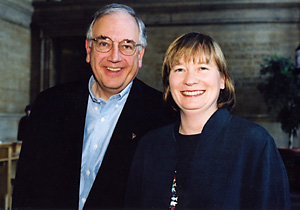 Bill Hecht '61, Alumni Association EVP & CEO, and Beth Garvin HM, Alumni Association Managing Director and Director of the Alumni Fund, after the announcement by the Association Board of Directors of the change in leadership slated for July 1, 2003. |
At the March 7 meeting of the Board of Directors, my retirement as executive vice president and CEO of the Association was announced. I will continue to serve MIT and the Alumni Association on a part time basis as CEO emeritus. By unanimous vote, the Board adopted the recommendation of the Presidents Committee that Elizabeth A. Garvin HM be appointed as my successor. She defined the desired outcomes of her administration to include:
- Engage more alumni with MIT.
- Strengthen communications with alumni.
- Maintain goal of lifelong engagement with alumni.
- Position the Association more effectively to assist in achieving broader goals of MIT.
- Increase fundraising in dollars and donors.
At the June meeting of the Board of Directors, Monica M. Ellis '91 was appointed director of the Alumni Fund.
In preparation for the expected reorganization by the new administration, open staff positions were held. Plans were made for the reallocation of resources to implement the planned reorganization, which will be announced on July 1, 2003 when Beth Garvin assumes the position of executive vice president and CEO.
Led by James A. Lash '66, 2002-2003 Association president, the staff worked throughout the last quarter of the year in preparation for this change in leadership. With his leadership and guidance, Beth and I worked closely to implement a smooth transition.
Process Improvements
At the beginning of FY2003, the Association announced an intention to implement a set of process improvements, designed for improved effectiveness and ultimately to produce cost reductions. Improvements included an automated phonathon system, a new data integrity team, online events tools, new web infrastructure, outsourcing of some services, and new quarterly budget reports.
The Alumni Fund implemented a new automated phonathon system called "CampusCall" which automates the identification of prospects for calls and the recording of call results. This tool has assisted the Tech Callers and has provided automated transfer of phonathon results to the Advance database. It has enabled callers to contact more alumni and has reduced the work of data entry staff whose time can now be used for proactive data cleanup and research. This has resulted in better quality data that benefits the entire MIT community.
A data integrity team was created to implement a proactive data cleanup and research component in our records maintenance. A great deal of data comes in from records updates completed online by alumni themselves. This past year, 45% of home address updates and 55% of work address updates occurred online. This increase in online updates markedly improved the integrity of our alumni records database. In addition, data feeds from other sources represented 14% of home address updates and 9% of work address updates.
Alumni* Work Address Updates
(counts reflect one update per entity per year)
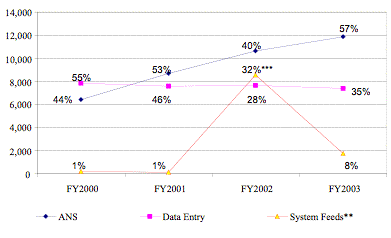
* Includes
alumni and postdocs
** Includes
PCI Directory Load, Sloan People Finder, Ruffalo Cody, Campus Call, and
Data Warehouse Loads
*** Number
inflated by directory questionnaire
Alumni* Home Address Updates
(counts reflect one update per entity per year)
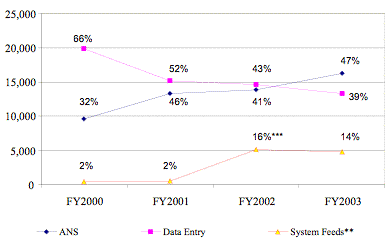
* Includes
alumni and postdocs
** Includes
PCI Directory Load, Sloan People Finder, Ruffalo Cody, Campus Call, and
Data Warehouse Loads
*** Number
inflated by directory questionnaire
In improvements to our web and Internet system support, Association staff:
- Launched a new online gift form
- Planned with MIT for growth in EFL support
- Implemented a new volunteer prospect system
- Replaced web development and production systems with Tomcat/Apache applications and web servers to increase the reliability of the web site
- Installed Samba, an open source software, to afford Windows users easy access to our Unix systems
- Upgraded Hitbox software to track web usage more effectively
- Contracted with Kintera to send bulk emails and track effectiveness of email campaigns
In addition, to reduce costs and use central services more effectively, we partnered with MIT-IS to become one of their first clients for their new, centralized printing services, thus reducing programming and maintenance costs for the Association.
Supporting Functions
The smooth functioning of a complex organization like the Alumni Association depends on effective support of the staff who work in the areas of personnel, finance, network support, mail services, programming and systems maintenance, space assignments, renovations, telecommunications, and information systems management. These staff members performed these functions with professionalism and high effectiveness.
The data integrity team recorded nearly 60,000 gifts and pledges this past year. They processed 9,500 credit card gifts, a new record. This group also processed 65,000 address updates and thousands of other biographical and other demographic updates.
To provide the necessary management information required by Association program managers, the programming staff produced thousands of reports each month, including hundreds of additional ad hoc requests throughout the year.
Staff Awards and Recognition
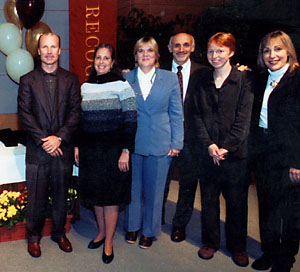 The ADVANCE Strategic Team from the Alumni Association, Resource Development and the Treasurer's Office won an MIT Excellence Award in the category of "Building Bridges." Team members are (L to R) Mark Jacobs, Bonny Kellermann '72, Rose McGrath, Joseph Recchio, Helen Rose and Shelley Brown. |
The Alumni Association was proud to be represented among the winners at the second annual MIT Excellence Awards Ceremony. One of two teams winning the Building Bridges award was the ADVANCE Strategic Team. This team, with staff members from the Alumni Association, Resource Development, and the Treasurer's Office, oversees the strategic management of the joint database of alumni records. Association team members were Mark H. Jacobs, director of Technical Services, and Joseph P. Recchio, director of Operations and Information Systems.
The Association participated for the second year in the Institute's Infinite Mile Award program. The Association's top awards, The Joseph S. Collins HM Awards, are presented annually to an outstanding individual staff member and team. In July 2002, at the annual staff summer retreat, the individual award was presented to Sarah Hendrick, program coordinator in the Alumni Activities and Geographic Programs unit. The group award went to the clubs group whose members were Louis Alexander HM, James Brogioli, Russell Boulais, Marilyn Finlay, Lauren McLean, Melissa Marquardt, and Christine Tempesta. Additionally, 52 appreciation awards ($25 gift certificates) were given to staff members.
As is true nearly every year, Association staff members were active in professional associations. This past year, Beth Garvin served as program chair for the CASE Districts I and II regional meeting in New York City in February 2003. Rose Resnik served as event chair for that conference. Joe Collins HM has been treasurer and a member of the board for CASE District I for several years.
Personnel
The total headcount for the Alumni Association this past year was 92. Because of the announced change in leadership, many open positions were held for an anticipated reorganization at the start of FY2003. During the year, we saw 13 terminations, 9 new hires, and 5 promotions. Kathryn Hankin was promoted to Alumni Affairs Officer III with responsibilities for the Parents and Students Programs; Anne Dowell was promoted to Alumni Affairs Officers II in Class Programs. Promoted retroactively to FY2002 were Sherry Colombaro to Alumni Affairs Officers II in Class Programs, and Heather Kispert to Alumni Affairs Officer I in Class Giving.
As noted above, effective July 1, 2003, Elizabeth Garvin HM became executive vice president and CEO, and Monica Ellis '91 was named director of the Alumni Fund. These promotions were by vote of the Alumni Association Board of Directors and were approved by the Executive Committee of the MIT Corporation. William Hecht '61 became CEO emeritus on a part-time basis.
Database Alumni Counts
Living Alumni with/without Address/Email
| Undergrad: | 58,844 |
| Grad: | 54,824 |
| Total: | 113,668 |
Living Alumni with Address/Email
| Undergrad | 51,564 |
| Grad | 46,476 |
| Total | 98,040 |
Living Alumni with Address/Email, Fund Active
| Undergrad: | 50,073 |
| Grad: | 43,402 |
| Total: | 93,475 |
Living Alumni with Email
| Undergrad | 37,365 |
| Grad | 30,267 |
| Total | 67,632 |
Living Alumni with Address/Email By Decade and Gender
| Male | % Male | Female | % Female | Total | % Total | |
| 1910's: | 9 |
100.00% |
0 |
0.00% |
9 |
0.01% |
| 1920's: | 195 |
97.50% |
5 |
2.50% |
200 |
0.20% |
| 1930's: | 1,252 |
97.58% |
31 |
2.42% |
1,283 |
1.31% |
| 1940's: | 5,273 |
97.34% |
144 |
2.66% |
5,417 |
5.53% |
| 1950's: | 9,763 |
98.27% |
172 |
1.73% |
9,935 |
10.14% |
| 1960's: | 12,043 |
96.93% |
381 |
3.07% |
12,424 |
12.67% |
| 1970's: | 14,753 |
88.79% |
1,863 |
11.21% |
16,616 |
16.95% |
| 1980's: | 16,085 |
79.18% |
4,229 |
20.82% |
20,314 |
20.72% |
| 1990's: | 16,035 |
72.20% |
6,175 |
27.80% |
22,210 |
22.66% |
| 2000's: | 6,516 |
67.78% |
3,098 |
32.22% |
9,614 |
9.81% |
| Total: | 81,924 |
83.58% |
16,098 |
16.42% |
98,022 |
Number of records without a gender code: 17
Living Alumni with Address/Email by Decade and Undergraduate/Graduate
| Ugrad | % Ugrad | Grad | % Grad | Total | % Total | |
| 1910's: | 9 |
100.00% |
0 |
0.00% |
9 |
0.01% |
| 1920's: | 199 |
99.50% |
1 |
0.50% |
200 |
0.20% |
| 1930's: | 1,017 |
79.27% |
266 |
20.73% |
1,283 |
1.31% |
| 1940's: | 4,006 |
73.94% |
1,412 |
26.06% |
5,418 |
5.53% |
| 1950's: | 6,437 |
64.78% |
3,499 |
35.22% |
9,936 |
10.13% |
| 1960's: | 7,152 |
57.57% |
5,272 |
42.43% |
12,424 |
12.67% |
| 1970's: | 8,758 |
52.71% |
7,858 |
47.29% |
16,616 |
16.95% |
| 1980's: | 9,771 |
48.08% |
10,551 |
51.92% |
20,322 |
20.73% |
| 1990's: | 10,083 |
45.39% |
12,133 |
54.61% |
22,216 |
22.66% |
| 2000's: | 4,131 |
52.96% |
5,484 |
57.04% |
9,615 |
9.81% |
| Total: | 51,563 |
52.59% |
46,476 |
47.41% |
98,039 |
Number of records without a class year: 1
Reflections
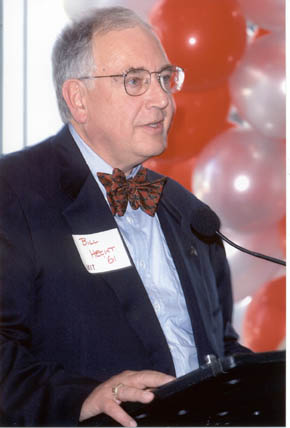 Bill Hecht '61 accepted congratulations after 23 years as Alumni Association Executive Vice President & CEO. |
It is a real challenge to try to sum up 23 years at the helm of the Association. I have been many times blessed. I have had a first rate staff, many of whom I helped recruit and develop. I have worked with a wonderfully supportive and constructively critical set of volunteers, again many of whom I helped involve. During this period, a truly accessible series of MIT administrations and I served together in a time when the spirit of change and openness to new ideas and approaches was abroad on the campus. The Alumni Fund grew six-fold, but we all pushed to make that happen. The demographics, gender, ethnicity, and geographic distribution of the alumni population changed dramatically. The greatest changes, perhaps, have been the increases in the number and mix of graduate alumni and the growth in the number of women in the alumni body. These changes demanded reasoned and thoughtful responses to be inclusive and keep the Association a relevant place. Now the Association and the Institute collaboratively must continue to make the needed adjustments to these changed realities.
There were many firsts in my tenure. In the position of Alumni Association president alone, the Association saw the first Californian, the first woman and the first graduate degree-only alumnus. Early in the 1980s, we launched an initiative to serve graduate alumni through their departments and started a very successful series of new programs for entrepreneurs, the MIT Enterprise Forum. In 1988 the Parents Program, including Family Weekend and a very successful Parents Fund, was started. The Association acquired and grew a very successful travel study program. We became a leader in Internet communications, email forwarding and networked services. These two decades have seen the creation of a number of special interest groups: BAMIT, the Black Alumni of MIT; CAMIT, the Chinese Alumni of MIT; MITAAA, the MIT Arab Alumni Association; LAMITA, Latin American MIT Alumni; and BGALA, the Bisexual, Gay, and Lesbian Alumni. We reached out to younger alumni, to those in need of career mentoring, and began tentative steps with the faculty to include alumni in the classroom and laboratory. Travel by the executive vice president and other Association staff expanded to include regular visits to alumni outside the United States.
With the lively collaboration of three vice presidents of development, we conducted two very successful capital campaigns that reached many more alumni and resulted in record alumni gifts in both size and percentage of the campaign totals. This was enabled by a creative series of outreach efforts to alumni at all levels, a strengthened Alumni Fund and wonderful volunteer involvement. We expanded to a comprehensive reunion gift program that paralleled the reunion events activities. We created the Henry B. Kane '24 Award for alumni fundraising excellence.
Technology Review was in its 81st year as the MIT alumni magazine with a modest outside circulation when I started the position of executive vice president. At that time, the EVP was also the publisher of Technology Review. In the early 80s, we expanded the circulation of the magazine to almost 100,000, half alumni and half paid non-alumni subscribers. Over the course of the next several years the Technology Review Board and the Association Board examined many alternatives to sustain and improve the magazine. In 1996, we hired a full-time publisher. Soon we renewed the editorial staff and relaunched the magazine. It met with substantial editorial and business success. In 2002, we negotiated with MIT essentially to sell the publication to the Institute, to continue to circulate the magazine to all alumni, and to retain its alumni section. In its 104th year, the magazine assumed its rightful place as MIT's magazine with national stature and over 300,000 subscribers.
We provided alumni input on several key Institute priorities including the Task Force on Student Life and Learning, and the Residence System Steering Committee. We created partnerships with a bank to provide an alumni credit card and with the COOP to offer MIT insignia products to alumni online.
I have had the fun of trying to adapt to these many changes. I inherited an organization that appeared to be broken. I pass along an organization that is in very good shape. Through it all, I counted on the professionalism of the staff, high quality, and dedicated volunteers, and an institution willing to engage its alumni more fully. I have been surrounded by the success of wonderful MIT alumni all over the world. It has been a true gift to have worked with people of quality, high standards, and expectations.
More information about the Alumni Association and its activities can be found on the web at http://alum.mit.edu/.